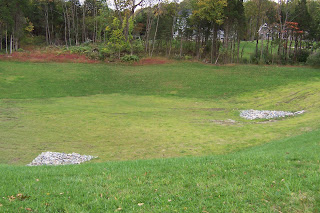Drawing the Eye Through the Garden

Using repetition and focal points to draw the eye through the garden makes it seem larger. We combined both techniques last fall and fulfilled a dream of many years by filling the middle space between the deer exclosure and the garden house with bulbs. We’ve tried small experiments in the past, such as planting Grape Hyacinths, but these were quickly nibbled to the nubs before they even had time to bloom.
Instead, there are Daffodils, which deer will not eat. In May, there will be blue Wood Hyacinths, though their fate in the deer stomping grounds is uncertain. Some escapees from the garden bloomed without incident in this space last year, so we were encouraged to try them.
There will also be pink Bleeding Heart, as I continue to remove the progeny of my original plant from the White Garden. Deer don’t like them, but they did get nibbled last year. Bleeding Heart are so prolific that it isn’t much of an effort to move them out back.
And, there are now enough Hellebores in the garden to try some outside the exclosure. We’ll find out this year whether or not the deer leave them alone.
The focal point is, of course, the garden house in the distance. We already had clumps of daffodils throughout the garden, so we used the new bulbs to build a visual connection from the existing garden to the garden house. This part of our property has a nearly-closed tree canopy come summer, so we concentrate our efforts on plants that bloom in the spring.
In a more formal space, the parallel lines of path edges can be used to pull the eye towards an urn, armillary sphere, sundial, etc., mounted on a column or plinth. In very small gardens, forced perspective can be created by angling the edges of the path towards one another. This creates the illusion that there is more depth than actually exists.
Instead, there are Daffodils, which deer will not eat. In May, there will be blue Wood Hyacinths, though their fate in the deer stomping grounds is uncertain. Some escapees from the garden bloomed without incident in this space last year, so we were encouraged to try them.
There will also be pink Bleeding Heart, as I continue to remove the progeny of my original plant from the White Garden. Deer don’t like them, but they did get nibbled last year. Bleeding Heart are so prolific that it isn’t much of an effort to move them out back.
And, there are now enough Hellebores in the garden to try some outside the exclosure. We’ll find out this year whether or not the deer leave them alone.
The focal point is, of course, the garden house in the distance. We already had clumps of daffodils throughout the garden, so we used the new bulbs to build a visual connection from the existing garden to the garden house. This part of our property has a nearly-closed tree canopy come summer, so we concentrate our efforts on plants that bloom in the spring.
In a more formal space, the parallel lines of path edges can be used to pull the eye towards an urn, armillary sphere, sundial, etc., mounted on a column or plinth. In very small gardens, forced perspective can be created by angling the edges of the path towards one another. This creates the illusion that there is more depth than actually exists.

